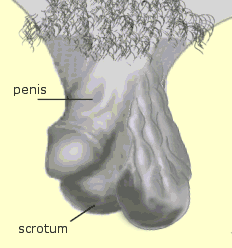|
Physical Problems in Males
|
|
Varicocele
|
|
A varicocele (from lat. varix: “varicose vein” + gr. kele: “break” or “cavity) is the enlargement of the network of tiny veins that move the blood circulation from the testicles upward toward the heart. The enlargement occurs when the one-way valves in these veins become weak. In that case, blood still easily flows down into the testicle, but has difficulty flowing back upward and out. As a result, the blood accumulates and stretches the veins, forming a tangled mass of varicose veins. As a rule, a varicocele is found only on the left side. The condition is fairly common, especially in younger men (ca.10% of all men are affected). Very often, it does not produce noticeable symptoms and is discovered only by accident in the course of some physical examination. However if a varicocele is large, it may cause some heavy feeling in the testicle or dull pain. It may even form a bluish swelling visible through the skin of the scrotum. A varicocele may also cause the testicle to shrink, and, since it raises the temperature inside the scrotum, it may be the cause of a man’s infertility.
Treatment
The treatment depends on the diagnosis. If the varicocele does not produce any symptoms, or it the symptoms are mild, some scrotal support or supportive underwear may suffice. However, if the patient feels pain, if his testicle has shrunk, and/or if he needs to be treated for his infertility, surgery may be required. Several traditional surgical techniques may be used to tie off the distended veins. The medical term for this is “varicocele ligation”. There is also a newer, less elaborate non-surgical procedure called “varicocele embolization”. It consists of introducing a thin tube through a small cut in the right side of the groin and guiding it through the veins to the left side where it can drain the varicocele. The tube then allows for the placement of a tiny coil that will block the vein, thereby achieving the same effect as a ligation.
|


